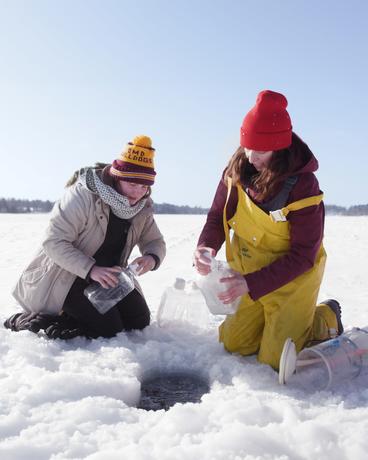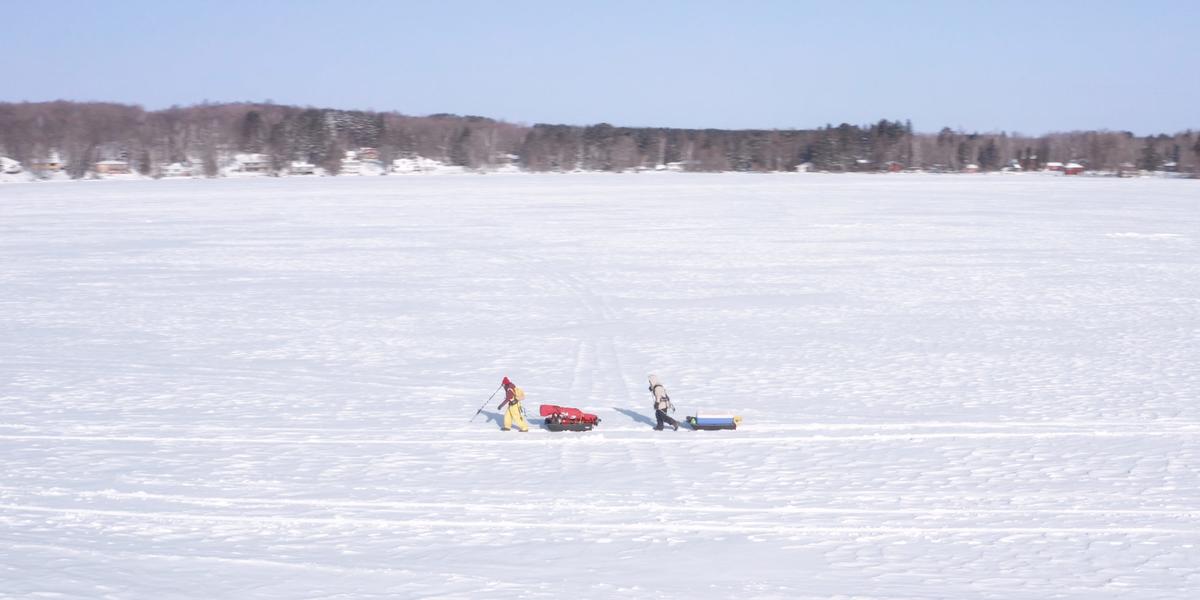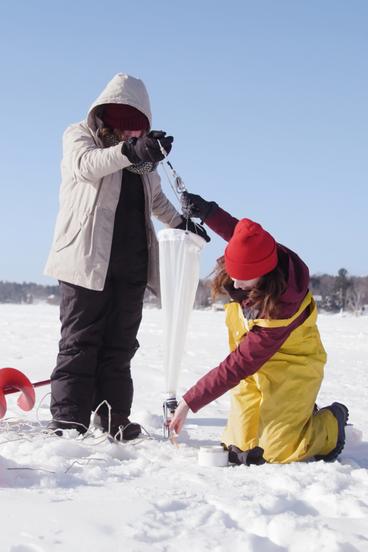Ecology under ice
UMD research is advancing our understanding of lake ecology in the winter.
It’s six below zero on a January morning. A steady wind from the north sweeps across Pike Lake in Duluth, carrying with it light sheets of dry snow. Bitter cold.
Dressed in layers and fully harnessed, two University of Minnesota Duluth (UMD) students pull sleds loaded with ice tools and research equipment to the geographical center of the lake. Their mission is to extract water and zooplankton samples to better understand what happens in Minnesota’s lakes during the winter.

“Here we are,” says Alia Benedict, a PhD student in the Water Resources Science program, as she reviews coordinates on a handheld GPS device. She takes a moment to catch her breath, which turns to frost on the ends of her hair, before unclipping her harness and unloading gear from her sled. She’s done this before.
Joining Benedict is Drew Check, a biology student who is part of the Undergraduate Research Opportunities Program (UROP) and embarking on her first winter water sampling trip. With a broad grin bordered by cheeks flushed with color from the long trek, she adjusts her maroon and gold “UMD Bulldogs” hat and helps Benedict unload gear.
“I’m learning so fast by doing hands-on work, and getting out here and living the experience,” says Check, who hopes to apply to UMD’s master’s program for Water Resources Science after completing her undergraduate degree.

The two work together to unfold a pop-up tent, which serves as a staging area for their equipment. They spend several minutes twisting large tie-down screws into the ice to prevent the tent from blowing away. Inside, a small heater glows orange in the corner and quickly fills the space with warmth. Outside the tent, Benedict drills two holes close together with an auger and uses a 6-foot Norwegian ice saw to cut out the section of ice between the holes, leaving an opening large enough to deploy their tools.

Huddled over the hole, Benedict explains to Check that most of the knowledge we have about our lakes comes from open-water seasons, but there’s a “black box” of data during winter months. “In order to understand how a changing climate will affect our lakes and the creatures within them,” says Benedict, “we need to understand what’s actually happening under the ice.”
The research outing is part of a larger effort led by Ted Ozersky, an associate professor in the Department of Biology and UMD's Large Lakes Observatory (LLO). Ozersky and his team have been busy collecting winter lake data across the state, filling a knowledge gap and working to better understand how reductions in ice coverage during Minnesota’s winters might affect lake ecology. Some fish species, Ozersky says, might benefit from reduced ice coverage, while other species will suffer. Understanding these changes can influence resource management actions like stocking and fishing regulations.
Back on the ice, Benedict walks Check through the process of deploying sampling equipment. The advice varies from subtle tidbits like how fast to retrieve a plankton net, to the mechanical workings of a Van Dorn bottle, an open-ended cylinder with hinged caps on either side used to sample water at desired depths.
“She loves to help and I love to learn, so it’s a great mix,” says Check.
After emptying a sample of zooplankton into a white cup, Benedict points out little lipid bubbles inside the tiny organisms darting about. “That’s what carries them through the winter,” she says. And as they study their samples, smiling despite the cold wind, it’s clear to see what carries these researchers through challenging winter conditions.
“It’s incredibly exciting to know that there’s a lot to be discovered,” says Benedict.
Latest News
- Master’s programs earn top spots in U.S. News & World ReportMaster’s programs earn top spots in U.S. News & World Report amesseng U of M Twin Cities and UMD hold first and second rankings in MN for both Best School For Social Work and Best Business School.
- Community-engaged researchCommunity-engaged research baume050 Interdisciplinary NIH research engages tribal community, undergraduates
- Right place, right resourcesRight place, right resources From hands-on computer science to natural resources fieldwork, Braden Kowalski found all the right tools at UMD.
- Finance, friendship, and fulfillmentFinance, friendship, and fulfillment kjorgen LSBE student Marisol Martinez creates a welcoming environment on campus.
- How will warmer winters impact our roads?How will warmer winters impact our roads? amesseng From record-setting cold and snow, to record-setting warmth, Minnesota's recent winters have been anything but normal, so we turned to UMD road expert Manik Barman to learn what this latest winter of new extremes means for Minnesotan roads.
- CEHSP staff spotlight: Amy MadsenCEHSP staff spotlight: Amy Madsen baume050 Meet Amy Madsen, Title IV-E Child Welfare Program Director since 2017






